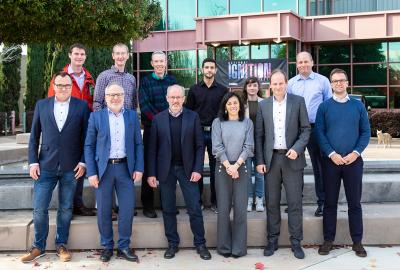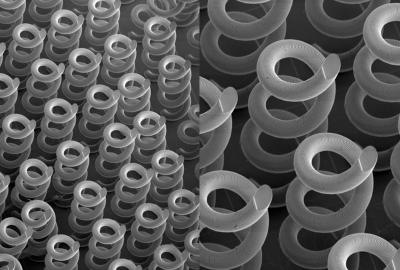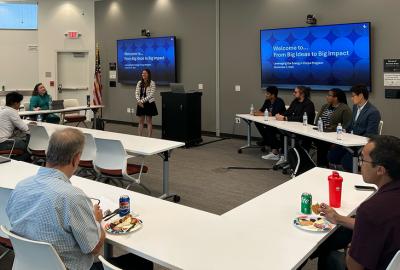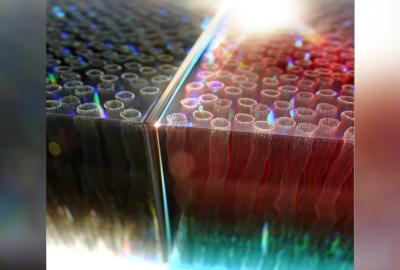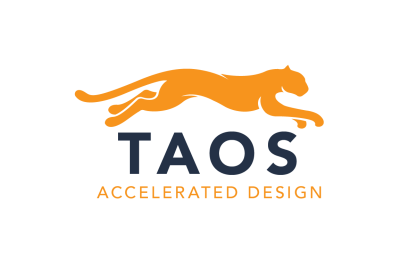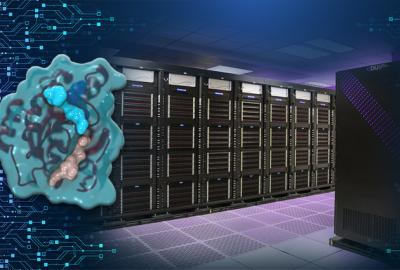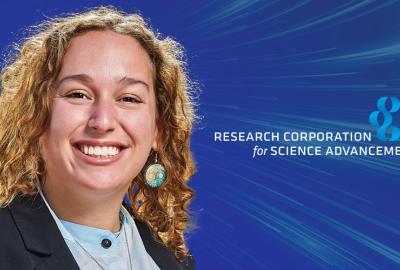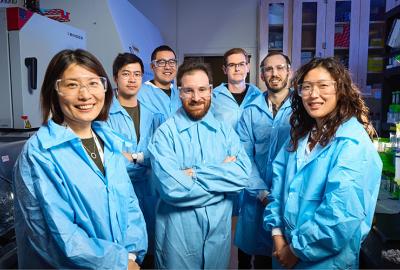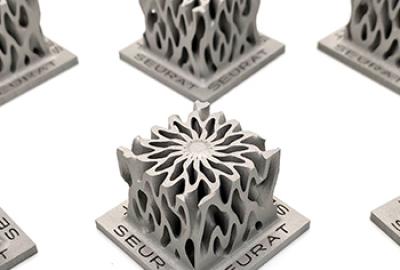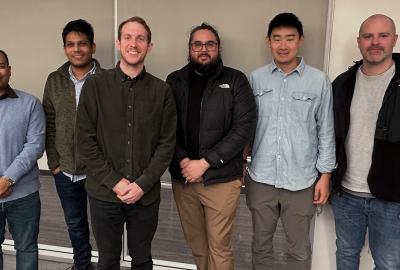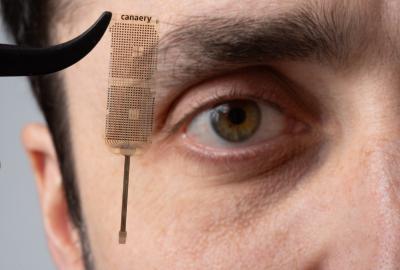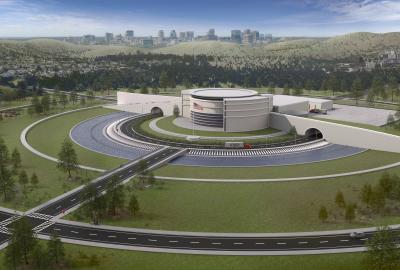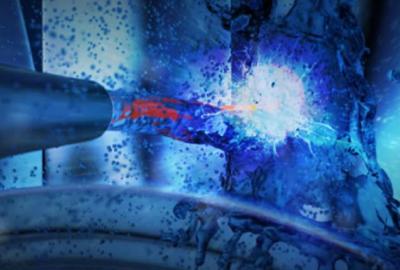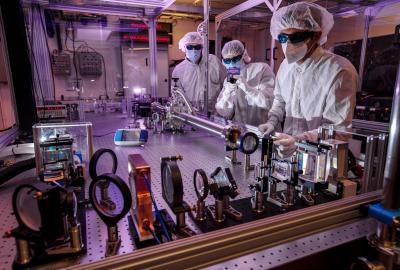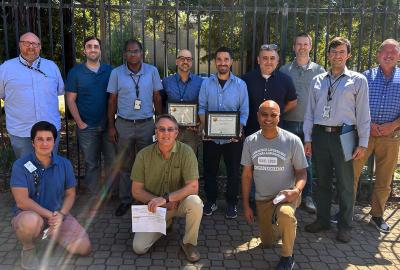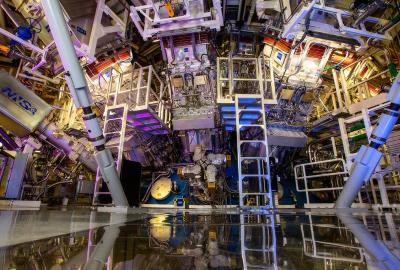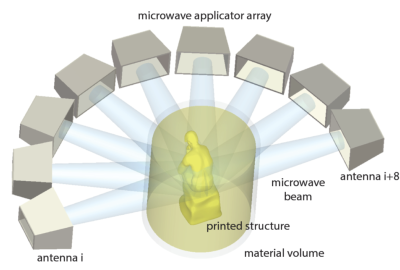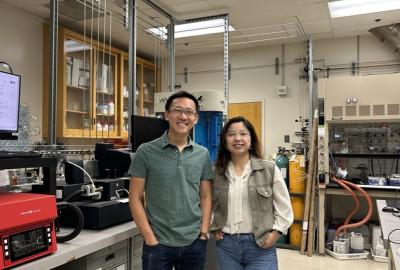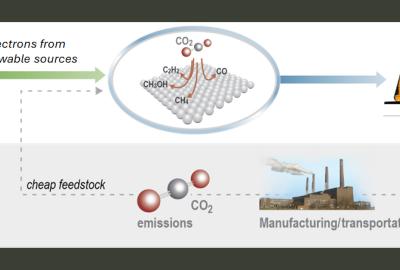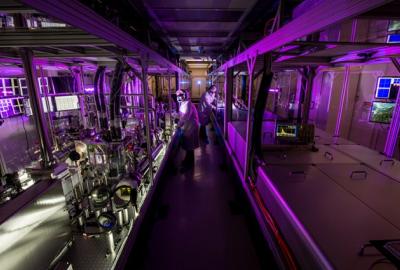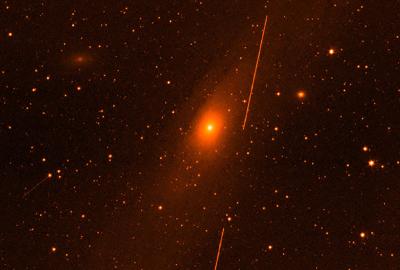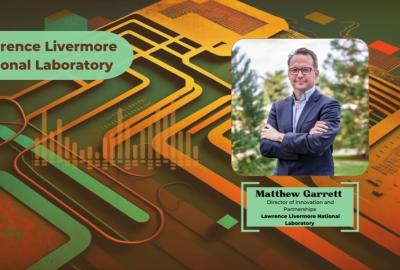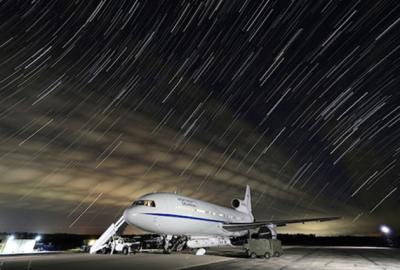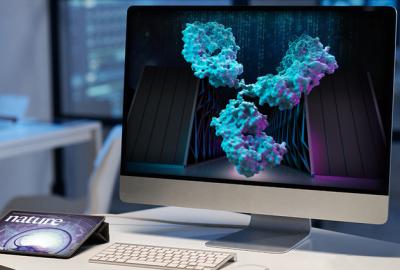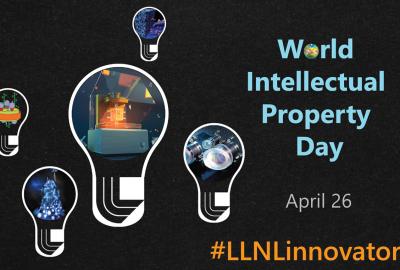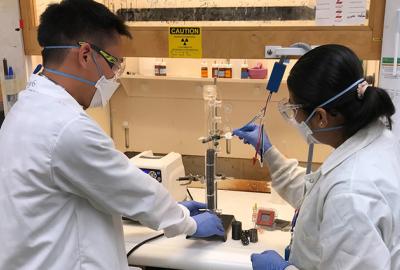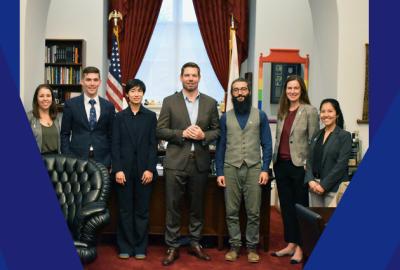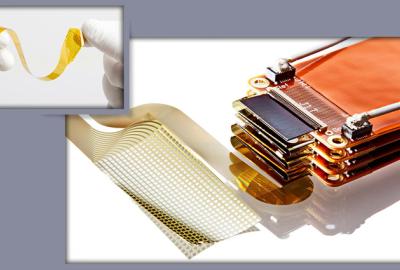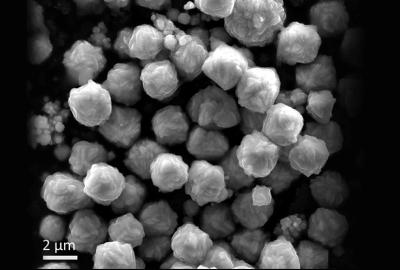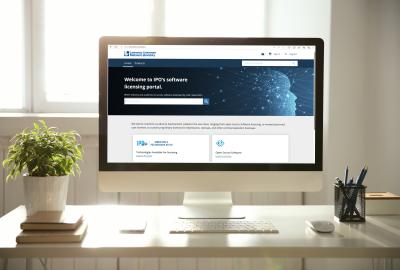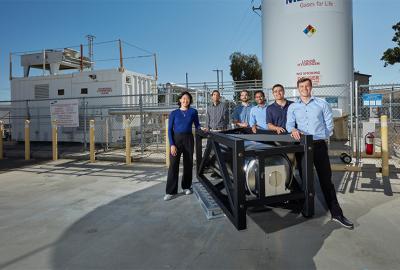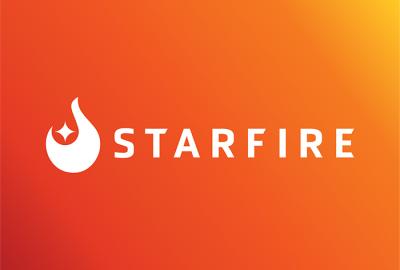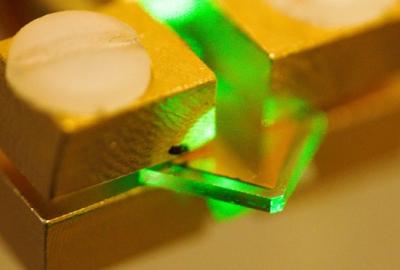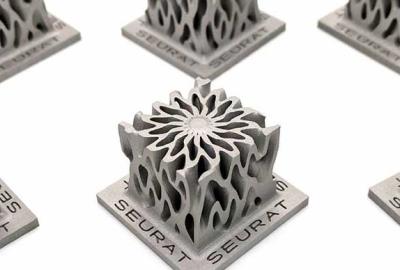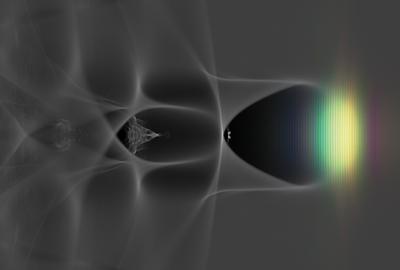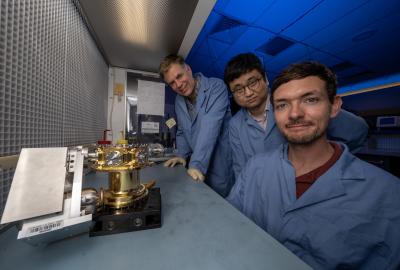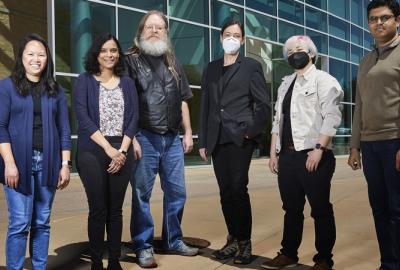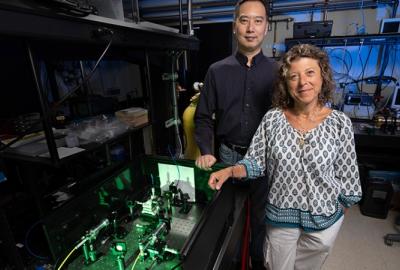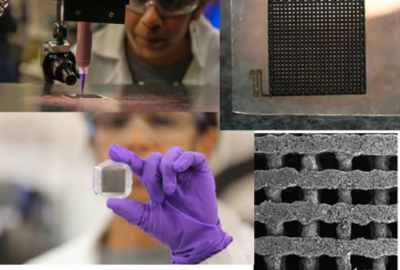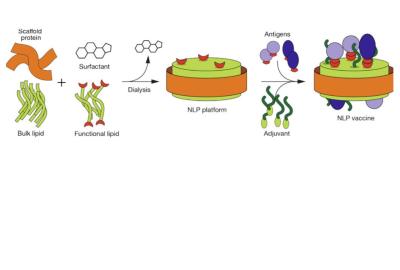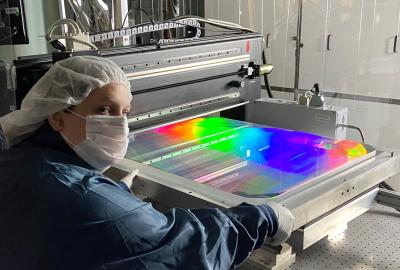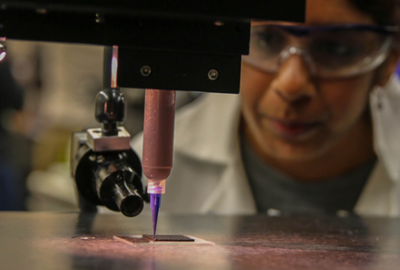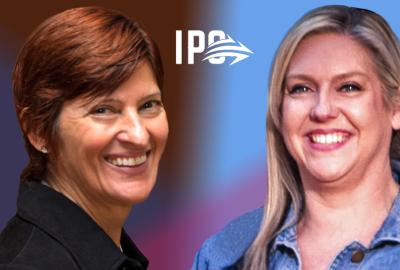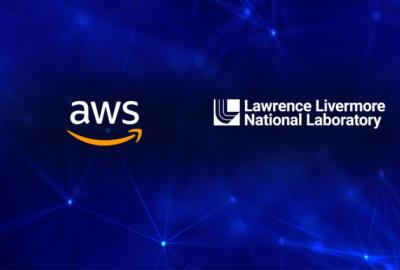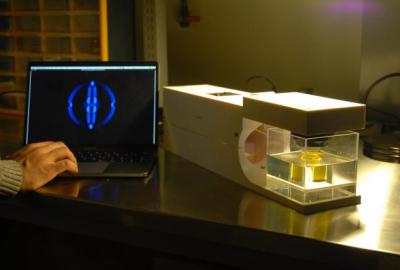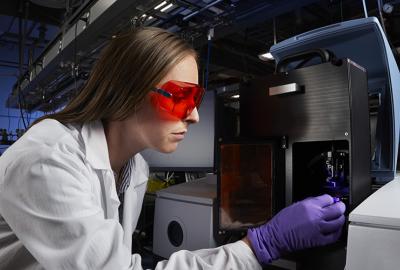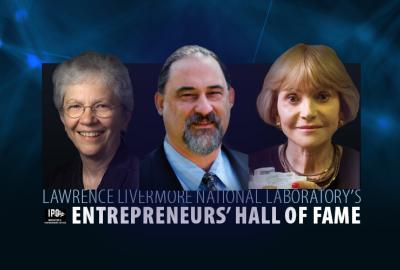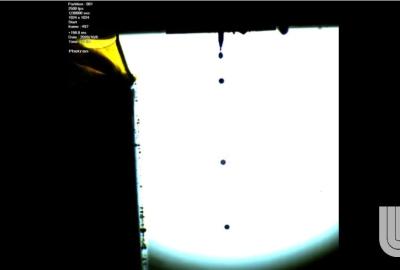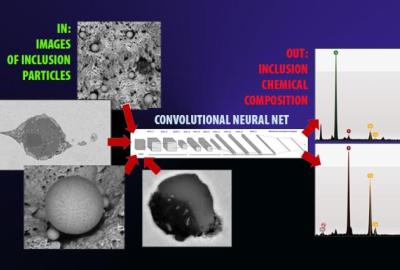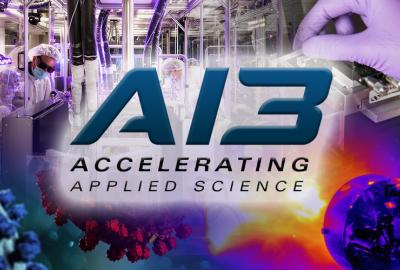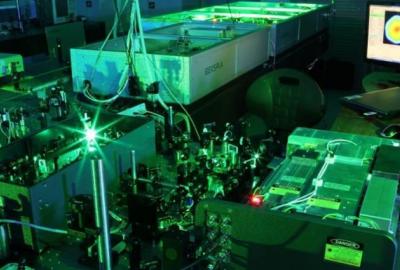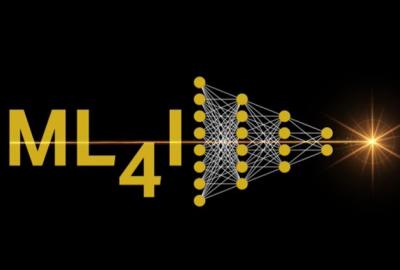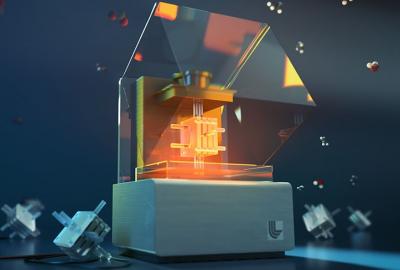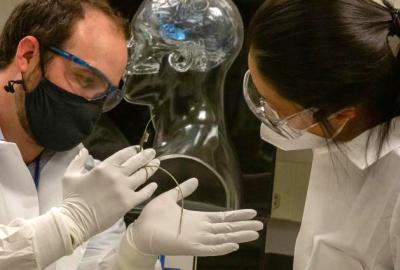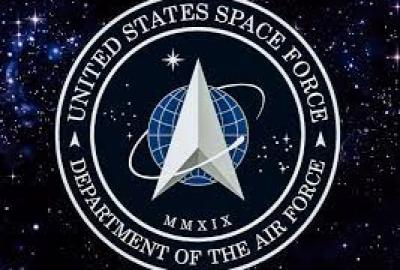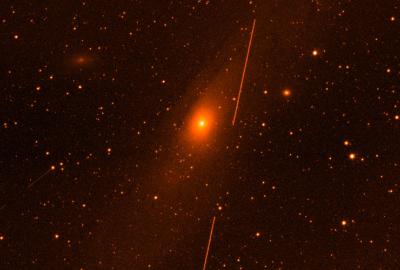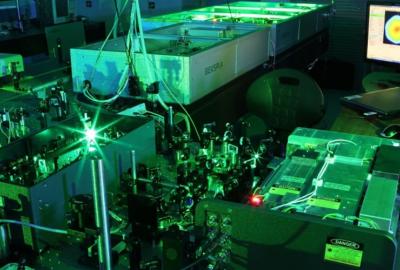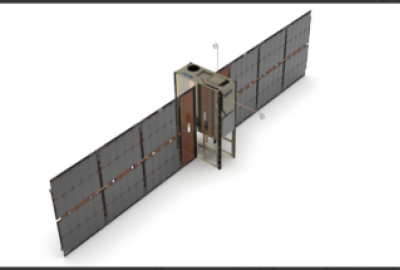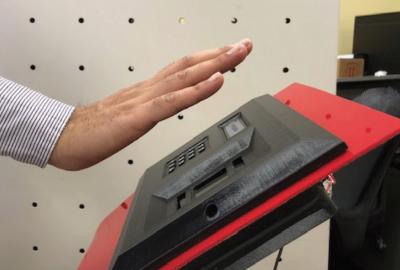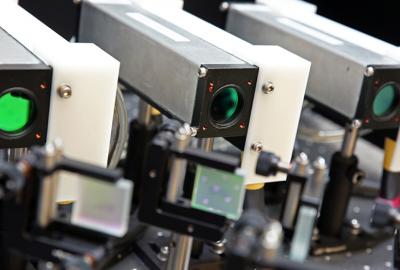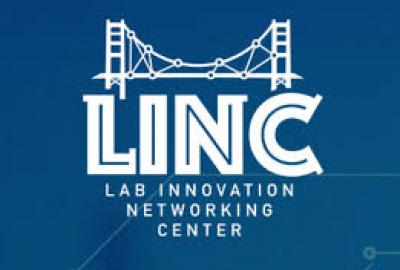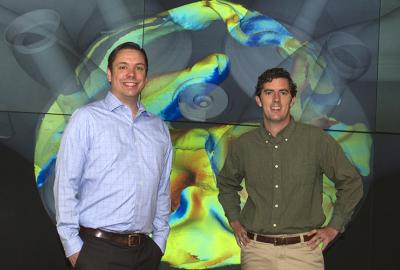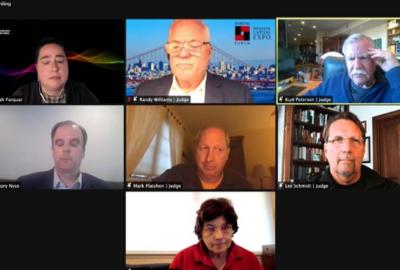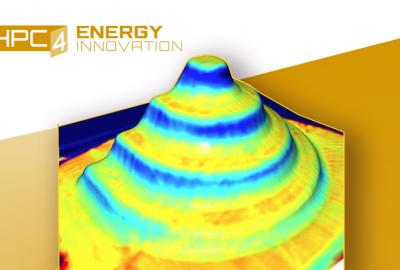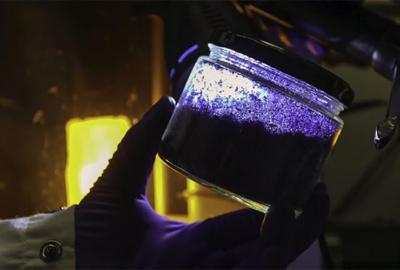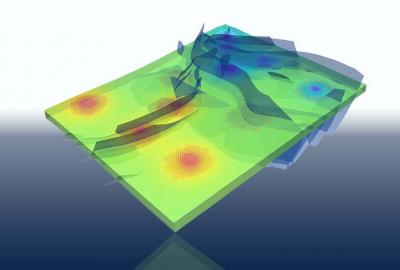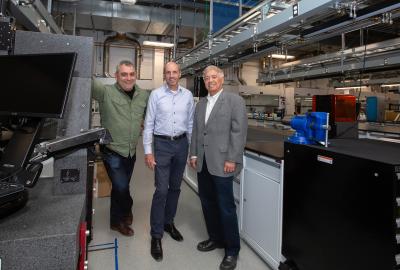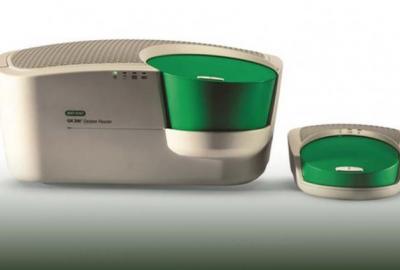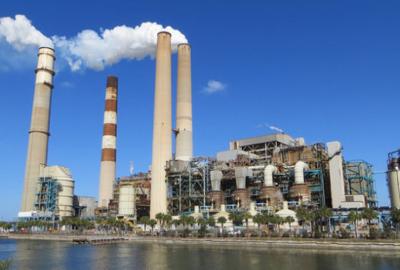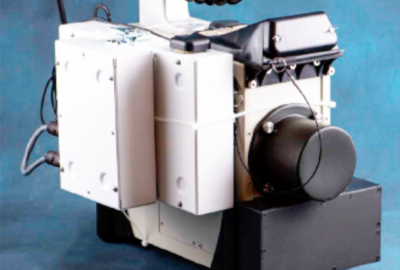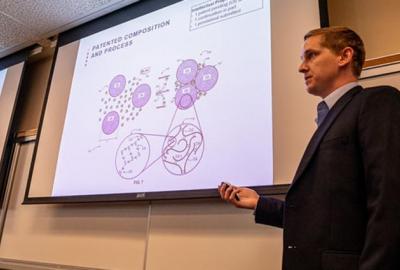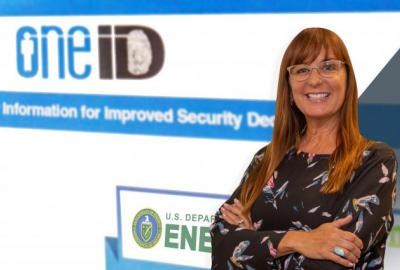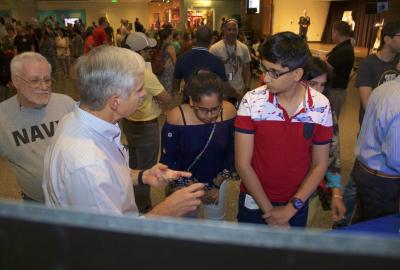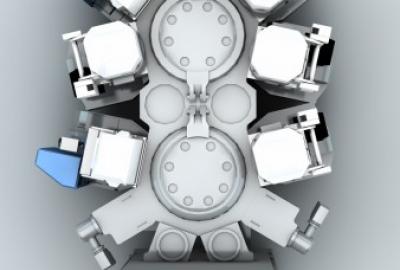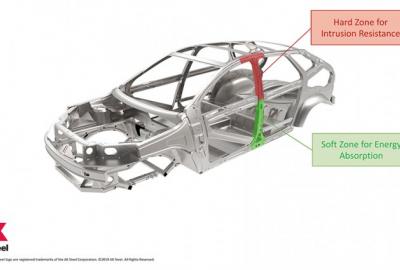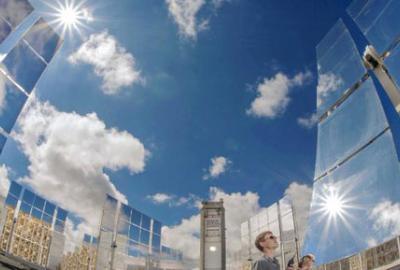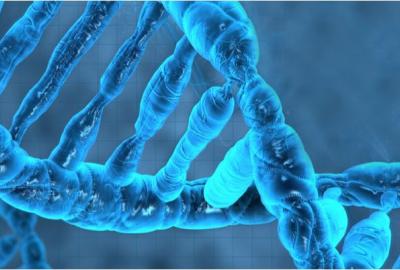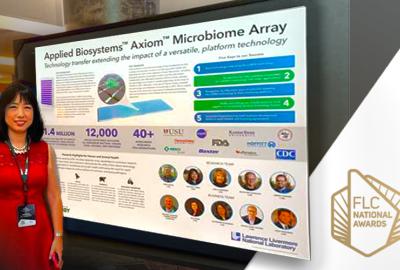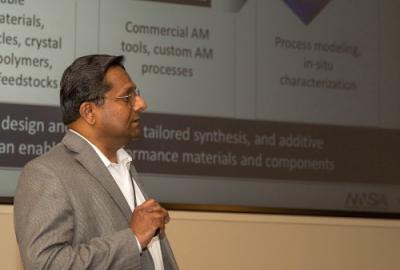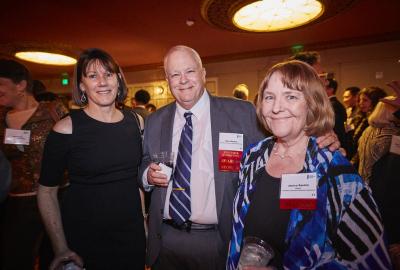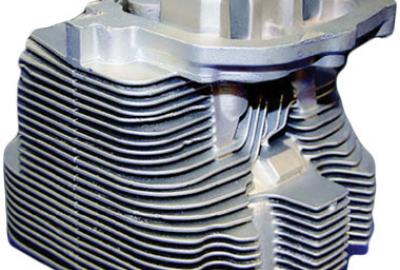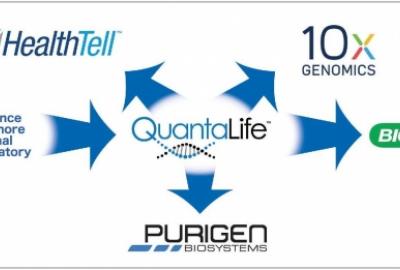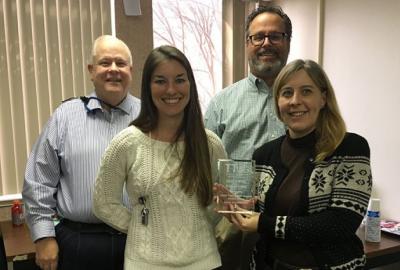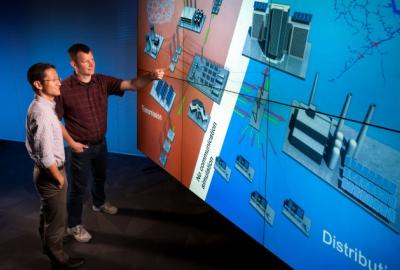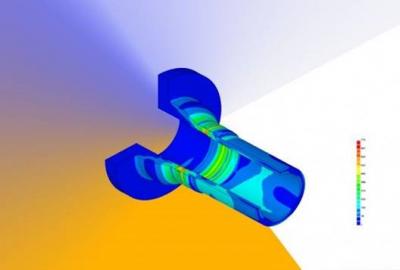Lawrence Livermore National Laboratory (LLNL) and Germany’s Fraunhofer Institute for Laser Technology (ILT) are joining forces to transition laser-ignited inertial fusion from experiments to industrial applications in a collaboration called ICONIC-FL (International Cooperation on Next-gen Inertial Confinement Fusion Lasers). Through a Cooperative Research and Development Agreement (CRADA) facilitated by LLNL’s Innovation and Partnerships Office (IPO), the two institutions will cross-validate their sophisticated laser simulation models to leverage complementary expertise.
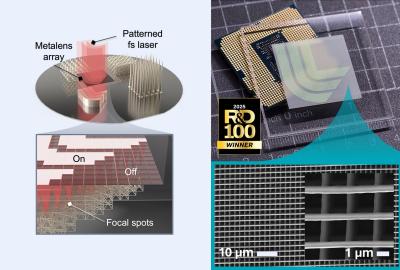
Lawrence Livermore National Laboratory (LLNL) engineers and scientists, in collaboration with Stanford University, have demonstrated a breakthrough 3D nanofabrication approach that transforms two-photon lithography (TPL) from a slow, lab-scale technique into a wafer-scale manufacturing tool without sacrificing submicron precision.
Published today in Nature, the team’s TPL platform uses large arrays of metalenses — engineered, ultrathin optical elements — to split a femtosecond laser into more than 120,000 coordinated focal spots that write simultaneously across centimeter-scale areas. The metalens-based method produces intricate 3D architectures with minimum feature sizes of 113 nanometers and achieves throughput more than a thousand times faster than commercial systems.
Researchers at Lawrence Livermore National Laboratory (LLNL) have optimized and 3D-printed helix structures as optical materials for Terahertz (THz) frequencies, a potential way to address a technology gap for next-generation telecommunications, non-destructive evaluation, chemical/biological sensing and more.
The printed microscale helixes reliably create circularly polarized beams in the THz range and, when arranged in patterned arrays, can function as a new type of Quick Response (QR) for advanced encryption/decryption. Their results, published in Advanced Science, represent the first full parametric analysis of helical structures for THz frequencies and show the potential of 3D printing for fabricating THz devices.
Previous attempts at making THz chiral structures have resulted in limited transmission and frequency range, but the team saw an opportunity to make something much more optimal with two-photon polymerization (2PP), an ultrahigh resolution light-based 3D printing technique.
LLNL pursues big ideas to solve the most important security challenges facing the U.S. and the world. In that pursuit, scientific breakthroughs with market potential are discovered, protected and licensed to (or collaborated on) with industry partners through a process called technology transfer. LLNL’s Innovation and Partnerships Office (IPO) facilitate this for the Laboratory across 10 technology portfolios. A key part of enabling the commercialization of LLNL technology for industry use is empowering entrepreneurship. At times, this leads to startup companies founded by Laboratory researchers, but often it looks more like empowering LLNL staff with an entrepreneurial mindset while approaching their mission-based work.
This is why LLNL was one of the first national laboratories to join the Department of Energy’s (DOE) Energy I-Corps (EIC) program as a pilot nearly a decade ago. Since then, 12 LLNL teams have participated in EIC Training Cohorts.
To address this critical energy need, the California Energy Commission recently awarded local startup DarmokTech and Lawrence Livermore National Laboratory (LLNL) a grant of $2 million over three years to pursue recyclable, sodium polymer-based batteries. The technology aims to enhance cost-effective energy storage and grid reliability in the state and beyond. The collaboration is indicative of the type of public-private partnerships that develop as a result of technology transfer and the entrepreneurial programs run by LLNL’s Innovation and Partnerships Office (IPO).
The trade journal R&D World Magazine recently announced the winners of the awards, often called the “Oscars of innovation,” recognizing new commercial products, technologies and materials that are available for sale or license for their technological significance.
Lawrence Livermore National Laboratory (LLNL) scientists and engineers have earned four awards among the top 100 inventions worldwide. With this year’s results, the Laboratory has now collected a total of 186 R&D 100 awards since 1978.
Submitted through LLNL’s Innovation and Partnerships Office (IPO), these awards recognize the impact that Livermore innovation, in collaboration with industry partners, can have on the U.S. economy as well as globally.
A multidisciplinary team of researchers at Lawrence Livermore National Laboratory (LLNL) developed a new type of electrically controlled, near-infrared smart window that can cut near-infrared light transmission by almost 50%. Their secret ingredient? Vertically aligned carbon nanotubes—tiny, tube-shaped structures made from carbon atoms that are thousands of times thinner than a human hair. The research was published in Nano Letters.
Information about the opportunity to license the technology can be found here: Electrochromic Devices Made from VACNTs
A recording of DOE Office of Technology Commercialization's National Lab Discovery Series webinar that introduces TAOS — The Alloy Optimization Software was recently posted. Discover how Lawrence Livermore National Laboratory is making metal alloy design faster, easier, and more accessible with TAOS.
TAOS is a cross-platform tool that helps users design new alloys based on target properties like melting temperature or phase stability — without requiring deep expertise in materials science. With an intuitive interface and powerful back-end modeling, TAOS allows users in aerospace, automotive, power generation, electronics and more to screen large multicomponent systems in minutes using a standard computer. This enables non-experts to develop new complex metal alloys for unique industrial applications in an accelerated, flexible and cost-efficent way. To learn more about TAOS, go to LLNL's software portal.
Lawrence Livermore National Laboratory (LLNL) and Starris: Optimax Space Systems have signed a Cooperative Research and Development Agreement (CRADA), expanding production of LLNL’s next-generation space domain awareness technology. Starris will serve as the manufacturing partner that can scale production of monolithic telescope technology to meet the needs for proliferated constellations.
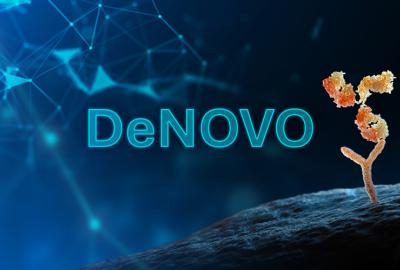
In a pioneering project aimed at revolutionizing the design of antibodies and antibody-like molecules through the power of AI, Lawrence Livermore National Laboratory (LLNL) is working to transform medical countermeasure development and biologics discovery. The project is part of an interagency agreement between the Advanced Research Projects Agency for Health and the Department of Energy.
Under the three-year DeNOVO project, LLNL and other institutions (including the University of California, San Francisco, the Institute for Protein Design at the University of Washington, Los Alamos National Laboratory and A-Alpha Bio) will apply high-performance computing and AI to push the boundaries of antibody design.
A new cancer drug candidate developed by Lawrence Livermore National Laboratory (LLNL), BBOT (BridgeBio Oncology Therapeutics) and the Frederick National Laboratory for Cancer Research (FNLCR) has demonstrated the ability to block tumor growth without triggering a common and debilitating side effect.
The discovery of BBO-10203 brings together DOE high-performance computing with AI and biomedical expertise to accelerate drug discovery. LLNL is leveraging its Livermore Computer-Aided Drug Design (LCADD) platform — combining AI and machine learning with physics-based modeling — and world-class DOE supercomputing resources like Ruby and Lassen, to simulate and predict drug behavior long before any compound is synthesized.
The Scialog: Automating Chemical Laboratories initiative has awarded Lawrence Livermore National Laboratory (LLNL) scientist Johanna Schwartz $60,000 to pursue automated design of next-generation membranes for fuel cells. The award comes as one of seven collaborative projects funded by the Research Corporation for Science Advancement (RCSA), the Arnold and Mabel Beckman Foundation and the Frederick Gardner Cottrell Foundation. Each project pairs advances in automation and AI with key questions in fundamental research.
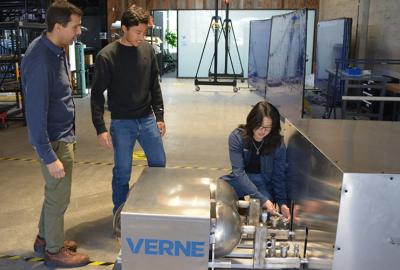
LLNL and Verne have demonstrated a novel pathway for creating high-density hydrogen through a research program funded by Department of Energy’s ARPA-E. The demonstration validated that it is possible to efficiently reach cryo-compressed hydrogen conditions with liquid hydrogen-like density directly from a source of gaseous hydrogen.
Verne began working with LLNL in 2021 through a Strategic Partnership Project to test Verne’s tanks at LLNL’s cryogenic hydrogen fueling facility. Collaborations progressed through two Cooperative Research and Development Agreements in 2023-24 facilitated by LLNL’s Innovation and Partnerships Office (IPO).
Rare-earth elements are essential for many electronic, energy and advanced defense technologies. A research collaboration between LLNL and Pennsylvania State University (Penn State) has generated a portfolio of intellectual property (IP), jointly owned by both organizations, that uses bacterial proteins to pick out critical metal ions.
LLNL has licensed its interest in the joint IP to advanced biochemistry start-up Alta Resource Technologies for commercialization of the resulting technology to transform mineral separation. Similarly, Penn State is negotiating a license agreement with Alta for its interest in the joint IP.
Seurat Technologies, a Massachusetts-based startup, licensed a LLNL-invented metal AM technology in 2015 with the intention of commercializing a high-speed, high-resolution 3D printer to produce metal parts at industrial scale. Since then, Seurat has developed the lasers, optics, and equipment needed to bring the technology to market, further strengthening LLNL’s mission-driven development of advanced materials and manufacturing processes. In this video, explore how Seurat, with investments from NVIDIA and others, could revolutionize metal additive manufacturing.
In a record setting year for Lawrence Livermore National Laboratory (LLNL), four teams of LLNL researchers will attend the Department of Energy’s (DOE) Energy I-Corps (EIC) Cohort 20 this spring.
The EIC is a key initiative of the DOE’s Office of Technology Commercialization, and facilitated at LLNL by Hannah Farquar from the Innovation and Partnerships Office (IPO). Established in 2015, EIC pairs teams of scientists with industry mentors to train researchers in moving DOE lab-developed technologies toward commercialization.
LLNL and neurotechnology company Canaery have developed an advanced nose-computer interface (NCI) capable of enhancing the ability of scent-detection animals to simultaneously identify contraband such as explosives and narcotics, as well as other types of important scents such as biomarkers for neurological and infectious diseases.
Nanofabrication of the implantable device is led by staff research engineer Travis Massey in LLNL’s Implantable Microsystems Group, and initially began under a Cooperative Research and Development Agreement (CRADA) through LLNL’s Innovation and Partnership’s Office (IPO). The work is now part of a strategic partnership between LLNL and Canaery.
Focused Energy and Lawrence Livermore National Laboratory (LLNL) today announced the signing of a Cooperative Research and Development Agreement (CRADA) to develop a model simulating the behavior of low-density foams wetted with liquid deuterium and tritium during implosion.
This follows a press release from Pacific Fusion just a week earlier where they announced that they have signed a CRADA with the Lab to build on National Ignition Facility's success in achieving ignition.
These collaborations with LLNL enable a new era of applied fusion. The CRADAs were facilitated through LLNL’s Innovation and Partnerships Office.
It’s the late 1990s. Lloyd Hackel and Brent Dane are researchers in Lawrence Livermore National Laboratory’s (LLNL) laser science and technology program.
They’re developing laser technology for X-ray lithography and satellite imaging research for the Department of Defense when the phone rings. On the line is Curtiss-Wright’s Metal Improvement Company (MIC) asking about something Hackel and Dane haven’t worked on before: high-peak-power laser peening for commercial applications in manufacturing.
This is an example of how LLNL’s mission-focused work advancing national security can lead to technology spin-offs with commercial importance through the Innovation and Partnerships Office (IPO).
For more, watch the YouTube video.
Decades of cutting-edge laser, optics and plasma physics research at Lawrence Livermore National Laboratory (LLNL) played a key role in the underlying science that the semiconductor industry uses to manufacture advanced microprocessors. Now a new research partnership led by LLNL aims to lay the groundwork for the next evolution of extreme ultraviolet (EUV) lithography, centered around a Lab-developed driver system dubbed the Big Aperture Thulium (BAT) laser.
LLNL plasma physicists, Brendan Reagan and Jackson Williams, are the project’s co-lead principal investigators. The project includes scientists from SLAC National Accelerator Laboratory; ASML San Diego; and the Advanced Research Center for Nanolithography (ARCNL), a public-private research center based in the Netherlands.
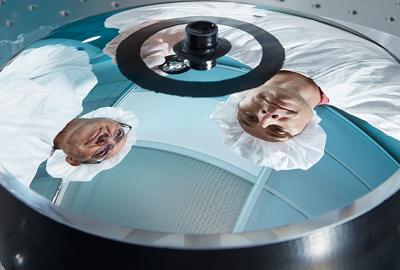
Starris: Optimax Space Systems and Lawrence Livermore National Laboratory (LLNL) have entered a commercialization partnership for LLNL’s patented monolithic telescope technology, which accelerates rapid deployment of modular optical designs for high-resolution or high-sensitivity space imagery.
Starris has collaborated over the last decade with LLNL’s Space Program to develop the monolithic telescope technology and will manufacture — at scale and with customization options — the precision-fabricated optical lens that forms the image in the telescope. The collaboration with LLNL is now extended via a government-use license for commercializing the technology through LLNL’s Innovation and Partnerships Office (IPO).
It was a laser shot for the ages. By achieving fusion ignition on December 5, 2022, LLNL proved that recreating the “fire” that fuels the sun and the stars inside a laboratory on Earth was indeed scientifically possible.
The achievement of ignition cemented LLNL’s position as a center of science and technology research directly relevant to inertial fusion energy (IFE) while sharpening the scientific community’s focus on developing this potentially clean, safe, enduring source of electricity for the world.
This story was originally published in the July 2024 edition of the American Nuclear Society magazine Nuclear News.
Technology designed to aid on-the-field diagnostics for military applications is gaining a wider reach as Lawrence Livermore National Laboratory (LLNL) and BioVind, LLC achieved a milestone in their partnership: the exclusive licensing of LLNL pathogen diagnostics technology focused on oil and gas applications.
The technology, called BioID, is a rapid and portable molecular diagnostics platform that can detect up to 18 target DNA or RNA sequences from a single sample in 30 to 60 minutes. BioID uses an isothermal amplification technique to detect pathogen nucleic acid.
Eight Lawrence Livermore National Laboratory (LLNL) researchers were recently honored by the Lab’s Engineering Principal Associate Directorate for their efforts in raising the Lab’s visibility and reputation through Strategic Partnership Projects (SPPs). The event was hosted by Rob Sharpe, Engineering's deputy principal associate director for research and development, who encouraged recipients to act as ambassadors for the program around the Lab.
US-based Longview Fusion Energy Systems and Lawrence Livermore National Laboratory (LLNL) have entered into a Cooperative Research & Development Agreement (CRADA) to develop a comprehensive performance and economic model tailored to optimise the Longview fusion power plant designs.
Through a new process a Lawrence Livermore National Laboratory (LLNL) team is calling Microwave Volumetric Additive Manufacturing (MVAM), researchers have introduced an innovative new approach to 3D printing using microwave energy to cure materials, opening the door to a broader range of materials than ever before.
Check out the technology page for MVAM!
Leaders from Lawrence Livermore National Laboratory (LLNL) and the Korea Advanced Institute of Science and Technology (KAIST) recently signed a memorandum of understanding (MOU), as they seek to expand collaborations related to their shared research interests in hydrogen and other low-carbon energy technology.
The two institutions have engaged in informal collaborations since 2018, sharing their knowledge via joint workshops on topics such as hydrogen storage and purification. In addition, experts from both institutions have produced multiple joint publications describing their hydrogen-related research. Other joint activities include a recent study exploring catalytic activity in electrochemical carbon dioxide conversion to products such as carbon monoxide and ethanol.
Lawrence Livermore National Laboratory (LLNL) scientists and engineers have earned three awards among the top 100 inventions worldwide. The trade journal R&D World Magazine recently announced the winners of the awards, often called the “Oscars of innovation,” recognizing new commercial products, technologies and materials that are available for sale or license for their technological significance. With this year’s results, the Laboratory has now collected a total of 182 R&D 100 awards since 1978. Submitted through LLNL’s Innovation and Partnerships Office, these awards recognize the impact that Livermore innovation, in collaboration with industry partners, can have on the U.S. economy as well as globally.
Lawrence Livermore National Laboratory (LLNL) researchers continue to capture key Department of Energy (DOE) Technology Commercialization Fund (TCF) grants with three new project grants announced in 2024.
This year’s TCF program support projects related to seismology, carbon dioxide removal and using simulations to create clean jet engines.
Coupling electrochemical conversion of the greenhouse gas CO2 with renewable electricity sources — such as solar and wind — promises green production of high-demand chemicals and transportation fuels. Carbon dioxide coupling products such as ethylene, ethanol and acetic acid are particularly useful as feedstocks for the chemical industry and powering vehicles.
To tackle this challenge, Lawrence Livermore National Laboratory (LLNL) and collaborators have developed a catalyst coating platform that used physical vapor deposition (PVD), which offers precise control over thickness, composition, morphology and porosity. The team includes researchers from the University of Delaware, Washington University and the University of Pennsylvania and industry partner Twelve Benefits Corporation
DOE’s Office of Technology Commercialization (OTC) has created the Visual Intellectual Property Search database, known as VIPS, to make it easier to perform intellectual property searches and find new technologies developed at DOE’s 17 National Laboratories and several additional DOE plants and sites. The database, officially launched July 31, draws primarily on two sources: patents issued by the U.S. Patent and Trademark Office and DOE CODE, a repository of software maintained by the U.S. Office of Scientific and Technical Information.
Check out the technologies LLNL has developed!
Following a Federal Laboratory Consortium (FLC) award win in April, Lawrence Livermore National Lab (LLNL) has received its second national recognition for collaborations surrounding the biomedical technology called nanolipoprotein particles (NLPs).
Yash Vaishnav, a business development executive within the Innovation and Partnerships Office (IPO), was recognized by the Department of Energy’s (DOE) Technology Transfer Working Group (TTWG) at its Spring Meeting, May 14-15, in Washington, D.C., for his work in negotiating the licensing agreement for LLNL’s NLP technology to EVOQ Therapeutics (EVOQ) — winning TTWG’s “Best in Class” award for licensing.
A new collaboration between the Fannie and John Hertz Foundation and Lawrence Livermore National Laboratory (LLNL) allows up to three Hertz Fellows a year to attend LLNL’s annual National Labs Entrepreneurship Academy.
The National Labs Entrepreneurship Academy is an intensive four-day commercialization program that gives researchers the tools to transfer their research and technologies out of the lab. Attendees hear lectures from experts in the technology development space and participate in hands-on exercises to craft and pitch their own commercialization ideas. LLNL’s long-time partner UC Davis Institute for Innovation and Entrepreneurship develops and presents the curriculum.
In a substantial milestone for supercomputing-aided drug design, Lawrence Livermore National Laboratory (LLNL) and BridgeBio Oncology Therapeutics (BridgeBio) today announced clinical trials have begun for a first-in-class medication that targets specific genetic mutations implicated in many types of cancer.
LLNL Innovation and Partnerships Office (IPO) Business Development Executive Yash Vaishnav negotiated the CRADA with BridgeBio subsidiary Theras, as well as the license agreement for the drug candidate with BridgeBio Oncology Therapeutics. Vaishnav also manages the intellectual property portfolio of KRAS inhibitors developed under the CRADA and the relationship with his counterparts at BridgeBio.
Funding from the Joint Program Executive Office for Chemical, Biological, Radiological and Nuclear Defense (JPEO-CBRND) will expand A-Alpha's partnership with Lawrence Livermore National Laboratory (LLNL) in support of the Generative Unconstrained Intelligent Drug Engineering (GUIDE) program. This announcement follows two years of successful collaboration between A-Alpha and LLNL – beginning with coronaviruses and expanding to multiple undisclosed pathogen families of concern – in which A-Alpha’s AlphaSeq data has been used to train ML models that predict antibody-antigen binding.
To learn more, see today’s press release here and coverage in Genetic Engineering & Biotechnology News.
The space vehicle integrates LLNL’s Monolithic Telescope (MonoTele) technology with Terran Orbital’s proven expertise producing high-reliability space vehicles. Developed through a four-year, $6 million cooperative research and development agreement (CRADA), this mission demonstrates the power of collaboration in advancing compact satellites for commercial applications.
Listen to the latest episode of the Silicon Valley Leadership Group's podcast featuring IPO Director Matt Garrett for a discussion on bridging the gap between innovators, scientists and potential investors.
Lawrence Livermore National Laboratory’s (LLNL) Space Program is now building an optical space domain awareness payload for an upcoming mission by the U.S. Space Force.
The planned mission, known as VICTUS HAZE, will be a tactically responsive space mission to demonstrate the ability to rapidly characterize an on-orbit threat.
The payload for VICTUS HAZE will use the LLNL monolithic telescope technology. LLNL’s monolithic telescopes are built out of a single piece of fused silica, eliminating the need for alignment and calibration after manufacture, while still providing the best possible resolution.
LLNL’s monolithic telescope was developed and patented by Lab employees Willem de Vries and Brian Bauman and former Lab employee Alex Pertica.
In a groundbreaking development for addressing future viral pandemics, a multi-institutional team involving Lawrence Livermore National Laboratory (LLNL) researchers has successfully combined an artificial intelligence (AI)-backed platform with supercomputing to redesign and restore the effectiveness of antibodies whose ability to fight viruses has been compromised by viral evolution.
The team’s research is published in the journal Nature and showcases a novel antibody design platform comprising experimental data, structural biology, bioinformatic modeling and molecular simulations — driven by a machine-learning algorithm.
World IP Day shines a light on the important role innovation plays in achieving the United Nations' (UN) 17 Sustainable Development Goals (SDGs), which aim to create a better future for everyone by protecting the planet. Lawrence Livermore National Laboratory’s (LLNL)’s Innovation and Partnerships Office (IPO) is taking the opportunity to recognize the numerous Lab inventors — and their inspiring innovations — that are making the world a better place.
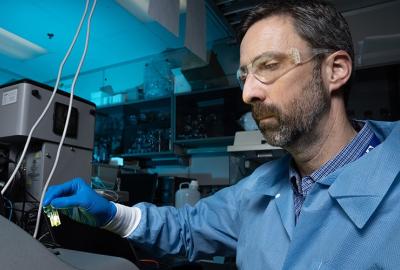
A Lawrence Livermore National Laboratory (LLNL) researcher and a colleague who helped him and his team commercialize their biomedical technology have garnered a national technology transfer award.
The award, from the Federal Laboratory Consortium (FLC), represents the 42nd technology transfer award that LLNL has won from the FLC since 1985.
LLNL researchers have partnered with Los Angeles-based SoCalGas and Munich, Germany-based Electrochaea to develop an electrobioreactor to allow excess renewable electricity from wind and solar sources to be stored in chemical bonds as renewable natural gas. Check out Electrochaea's press release: Electrochaea signs CRADA.
The work is funded with $1 million from the Technology Commercialization Fund of the DOE Industrial Efficiency and Decarbonization Office, a division of the Office of Energy Efficiency and Renewable Energy. Partners will provide $1 million in in-kind contributions or research funds.
At LLNL, Huang and Ford are working toward developing a new method to make high-performance silicone parts that can be 3D printed and cured using ultraviolet light. The researchers participated in the Department of Energy’s Energy I-Corps Program, an immersive eight-week entrepreneurial boot camp that teaches scientists and engineers the tools of the trade for commercializing technology from the Lab to the marketplace.
While the Energy I-Corps program is funded by the DOE Office of Technology Transitions, the participation of LLNL’s Ford and Huang in the program was funded by the National Nuclear Security Administration.
Lawrence Livermore National Laboratory (LLNL) has joined forces with Precision Neuroscience Corporation (Precision) to advance the technology of neural implants for patients suffering from a variety of neurological disorders, including stroke, spinal cord injury and neurodegenerative diseases such as Lou Gehrig's disease.
Under the three-year collaboration, outlined in a Cooperative Research and Development Agreement (CRADA), LLNL scientists and engineers will work with Precision to develop future versions of the company’s neural implant – a thin-film microelectrode array called the Layer 7 Cortical Interface – with enhanced longevity.
The development of new antibiotics has stalled — new strategies are needed as the world enters the age of antibiotic resistance. To combat this challenge, Lawrence Livermore National Laboratory (LLNL) scientists have found that synthetic antibacterial minerals exhibit potent antibacterial activity against topical MRSA infections and increase the rate of wound closure.
A patent has been filed on this technology and Morrison’s research team is looking for industry partners to help commercialize this novel antimicrobial approach; click here for more information regarding partnership and licensing opportunities.
The Innovation and Partnerships Office (IPO) has launched a new software licensing portal to facilitate the adoption of the diverse proprietary software solutions developed by Lawrence Livermore National Laboratory (LLNL) researchers.
BBO-8520’s discovery was the result of a collaboration between the RAS Initiative FNL, Lawrence Livermore National Laboratory, and BridgeBio. It is specifically designed to provide patients afflicted with KRASG12C mutant cancers with a best-in-class, oral small molecule therapy that directly targets the tumor at its source – oncogenic KRASG12C GTP-bound (ON) signaling. Enrollment of patients with KRASG12C mutant non-small cell lung cancer into the ONKORAS-101 trial is expected to begin in H1 of this year.
Lawrence Livermore National Laboratory (LLNL) and Verne, a San Francisco-based startup, have demonstrated a cryo-compressed hydrogen storage system of suitable scale for heavy-duty vehicles. This is the first time cryo-compressed hydrogen storage has been demonstrated at a scale large enough to be useful for semi trucks, a milestone in high-density hydrogen storage.
The U.S. Department of Energy (DOE) has awarded a four-year, $16 million project to a multi-institutional team led by LLNL to accelerate inertial fusion energy (IFE) science and technology. The Science and Technology Accelerated Research for Fusion Innovation and Reactor Engineering (STARFIRE) Hub consists of members from seven universities, four U.S. national labs, one international lab, three commercial entities, one philanthropic organization and three private IFE companies.
In addition to researchers from LLNL, other participants include General Atomics; UC San Diego; UC Berkeley; UCLA; University of Rochester; MIT; University of Oklahoma; Texas A&M University; Fraunhofer Institute for Laser Technology; TRUMPF Inc.; Leonardo Electronics US Inc.; the Livermore Lab Foundation; SLAC; ORNL; SRNL; Xcimer Energy; Focused Energy Inc.; and Longview Fusion Energy Systems.
Funded through DOE’s Unlocking Lasting Transformative Resiliency Advances by Faster Actuation of power Semiconductor Technologies (ULTRAFAST) program, LLNL researchers (in Engineering) will develop an optically-controlled semiconductor transistor to enable future grid control systems to accommodate higher voltage and current than state-of-the-art devices. (Award amount: $3,000,000) while LLNL licensee Opcondys will develop a light-controlled grid protection device to suppress destructive, sudden transient surges on the grid such as those caused by lightning and electromagnetic pulses. (Award amount: $3,178,977)
On October 30, 2023, LLNL licensee, Seurat Technologies, announced a $99 million Series C round. Seurat’s pioneering approach was originally developed right here at LLNL. The underlying technology for Seurat was created to solve a manufacturing problem in building an actual fusion power plant based on the architecture at the National Ignition Facility (NIF).
Today we can see inside seemingly impossible places thanks to muon imaging. This technique uses muons, which can penetrate far deeper than possible with x rays. But this process is also slow. Scientists at Lawrence Livermore National Laboratory (LLNL) are working to change that with a new initiative called Intense and Compact Muon Sources for Science and Security (ICMuS2).
Partnering with industry and academic researchers, the initiative seeks to rapidly generate these particles using high power lasers. The project is funded by the Defense Advanced Research Projects Agency’s Muons for Science and Security Program.
An instrument designed and built by LLNL researchers departed Earth last week on a two-billion-mile, nearly six-year journey through space to explore a rare, largely metal asteroid.
The Livermore high-purity germanium (HPGe) gamma-ray sensor is an essential part of a larger gamma-ray spectrometer (GRS) built in collaboration with researchers from Johns Hopkins Applied Physics Laboratory (JHAPL) in Laurel, Maryland. It is part of a suite of instruments set to make the first-ever visit to Psyche, the largest metal asteroid in the solar system. The Psyche mission is led by Arizona State University (ASU).
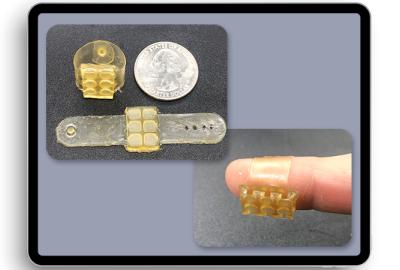
Engineers and chemists at Lawrence Livermore National Laboratory (LLNL) and Meta have developed a new kind of 3D-printed material capable of replicating characteristics of biological tissue, an advancement that could impact the future of “augmented humanity.”
Lawrence Livermore National Laboratory (LLNL) scientists and engineers have netted three awards among the top 100 inventions worldwide. The trade journal R&D World Magazine recently announced the winners of the awards, often called the “Oscars of innovation,” recognizing new commercial products, technologies and materials that are available for sale or license for their technological significance.
José Hernández’s life story can now be found on the small screen with the new film “A Million Miles Away”. Of note in the article, Hernández stated he is “most proud of is the fact that the Lab embraced the digital mammography project, the work Clint Logan, Laura Mascio and I did, allowed us to assist a private company to make a product that was better than what was available at the time. I look back and know that project has saved lives. That is what makes me most proud”. This collaboration with the private company was facilitated by staff of IPO, which back then was called IPAC (Industrial Partnerships and Commercialization Office).
Lawrence Livermore National Laboratory (LLNL) researchers have racked up another top-notch year for securing grants through the Department of Energy’s (DOE) Technology Commercialization Fund (TCF) program. Under this year’s TCF program, LLNL researchers will receive about $1.73 million, with $892,000 from the DOE and $845,000 from the Lab’s IPO and industrial partners. The secured grants are for developing hydrogen storage for heavy-duty trucks, new battery to aid grid storage, hydrogen sensor for environmental monitoring and empowering self-assembling microgrids.
LLNL developed technology known as Energy Inks has won a best in region award for the Far West region from the Federal Laboratory Consortium for Technology Transfer (FLC). LLNL researchers are supported by the Lab’s Innovation and Partnerships Office staff, particularly business development executive Genaro Mempin, who oversees the commercialization efforts for Energy Inks, and digital assets coordinator Mary Holden-Sanchez, who manages LLNL’s submission process for technology transfer award programs.
Seurat Technologies announced an agreement to develop 59 tons of additively manufactured metal components for Siemens Energy turbines. Seurat’s pioneering approach was originally developed right here at LLNL. The underlying technology for Seurat was created to solve a manufacturing problem in building an actual fusion power plant based on the architecture at the National Ignition Facility (NIF).
Harmful biological pathogens, such as viruses, bacteria, fungi, protozoa, and worms, continue to pose a threat to the Joint Force. To combat these natural challenges and better defend warfighters from bioterrorism and biowarfare, the DTRA's Chemical and Biological Technologies Department in its role as the JSTO for the Chemical and Biological Defense Program collaborated with researchers at LLNL to create and evaluate a nanolipoprotein (NLP)-based multipathogen vaccine platform...
In late 2017, LLNL licensed a biomedical technology called nanolipoprotein particles (NLPs), which can deliver vaccines and drugs inside the cells in the human body, to Ann Arbor, Michigan-based EVOQ Therapeutics. EVOQ Therapeutics has announced two major agreements with Gilead Sciences Inc. and Amgen Inc. to work on the preclinical development of novel medicines to combat autoimmune diseases.
R&D World Magazine recently announced their 2022 award winners. LLNL researchers received three awards, which include Tailored Glass by Direct Ink Writing, novel compression gratings that enable a new class of high-energy laser systems and a 3D printing feedstock known as Energy Inks that can print a functioning battery.
Last week SLAC and LLNL co-hosted the National Accelerator Lab Pitch Event, where scientists from national labs come together to present their technology commercialization work to seasoned investors.
Lawrence Livermore National Laboratory has developed GridDS — an open-source, data-science toolkit for power and data engineers that will provide an integrated energy data storage and augmentation infrastructure, as well as a flexible and comprehensive set of state-of-the-art machine-learning models.
LLNL, Penn State, Columbia University, Tufts University, University of Kentucky, Purdue University and industry partner Western Rare Earths will use microbial and biomolecular engineering to develop a scalable bio-based separation and purification strategy for rare-earth elements
Lawrence Livermore National Laboratory is partnering with Ampcera Inc. to develop solvent-free Laser Powder Bed Fusion additive manufacturing technologies for the fabrication of 3D-structured lithium battery cathodes, that could result in faster charging and higher-energy-density batteries.
The Department of Energy’s Technology Transfer Working Group recently awarded two Lawrence Livermore National Laboratory (LLNL) employees with “Best in Class” awards during their May spring meeting in Washington, D.C.
Lawrence Livermore National Lab and Amazon Web Services will explore software and hardware solutions spanning cloud and on-premises HPC environments, and establish a common stack of open-source software components that can run well in large HPC centers and on cloud resources.
The Department of Energy launched the spring 2022 solicitation for the High Performance Computing for Energy Innovation (HPC4EI) initiative, seeking proposals from industry that address key energy and decarbonization-related challenges in domestic manufacturing.
NASA's funding will enable LLNL and Kentucky-based space life sciences company, Space Tango to mature prototypes of the “replicator” technology — a ultrafast 3D printer co-developed by LLNL and the University of California, Berkeley — for bioprinting in microgravity on the International Space Station.
Researchers at Lawrence Livermore National Laboratory and the University of California, Berkeley have demonstrated the ability to 3D-print microscopic objects in silica glass, part of an effort to produce delicate, layer-less optics that can be built in seconds
A trio of LLNL scientists have been inducted into the laboratory's Entrepreneur's Hall of Fame. Each developed technologies during or after their Lab careers that created major economic impacts or spawned new companies.
Seurat Technologies was born from a problem CEO James DeMuth encountered while working at Lawrence Livermore National Laboratory’s National Ignition Facility. The solution is a new way to dramatically speed up large-scale metal 3D manufacturing while assuring high quality finished products.
Seurat Technologies, the 3D metal printing leader that is making manufacturing better for people and the planet, has closed a $21M Series B extension with investments from new investors Xerox Ventures and SIP Global Partners.
Lawrence Livermore National Laboratory is developing a new diagnostic tool that can determine the quality of metal droplets and monitor liquid metal jetting prints in real time.
A Lawrence Livermore National Laboratory-led collaboration targeted at using machine learning to reduce defects and carbon emissions in steelmaking.
Lawrence Livermore National Laboratory has established the AI Innovation Incubator to unite artificial intelligence experts from LLNL, industry and academia for the advancement of AI for large-scale scientific and commercial applications.
Lawrence Livermore National Laboratory scientists and engineers have collected three R&D 100 Awards. Often called the “Oscars of invention", the R&D 100 Awards recognize the top 100 industrial inventions worldwide.
Leaders from the National Nuclear Security Administration, Congressional representatives and local elected officials gathered at Lawrence Livermore National Laboratory to celebrate the expansion of the Livermore Valley Open Campus.
LLNL held its first-ever Machine Learning for Industry Forum on August 10-12. Co-hosted by the Lab’s High Performance Computing Innovation Center and Data Science Institute, the virtual event brought together more than 500 participants from the Department of Energy complex, commercial companies, professional societies and academia.
Lawrence Livermore National Laboratory scientists and their collaborators are leveraging 3D printing to improve the performance of electrochemical reactors used to convert CO2 into useful energy sources, chemicals and material feedstocks.
Thin-film electrodes developed at Lawrence Livermore National Laboratory have been used in human patients at the University of California, San Francisco, generating never-before-seen recordings of brain activity in the hippocampus, a region responsible for memory and other cognitive functions.
The decades-long quest for fusion energy and an innovative technique for protecting the National Ignition Facility's optical components from laser damage were the inspiration for a new high-speed 3D manufacturing technology that’s about to enter the market.
Scientists at Lawrence Livermore National Laboratory have determined that heating N95 respirators up to 75 degrees Celsius for 30 minutes deactivates a surrogate coronavirus without compromising the device’s fit and its ability to filter airborne particles.
When the U.S. Space Force’s Tactically Responsive Launch-2 (TacRL-2) mission launched from Vandenberg Space Force Base on June 13, it carried a payload designed and built in record time by Lawrence Livermore National Laboratore.
Tyvak released the first images of objects in orbit and on the ground captured by telescopes developed with the Lawrence Livermore National Laboratory.
Seurat Technologies closed a $41 million Series B round of funding led by Capricorn’s Technology Impact Fund. The funds will be used to further accelerate the development and commercialization of Seurat’s pioneering metal additive manufacturing technology, Area Printing™
It is with deep sadness that we acknowledge the passing of Gerald “Jerry” Burke. Burke and colleagues created the Numerical Electromagnetic Code (NEC), an antenna modeling system for wire and surface antennas. NEC’s ability to calculate currents more accurately along the antenna wires, and the junctions between them, offered a significant improvement over the Antenna Modeling Program (AMP2) that was being used at the time. NEC became a game-changer for antenna mapping. It gave the Navy insight into how a ship’s structure would affect an antenna’s performance and inform modifications to both ship and antenna designs. The result was significantly improved radar and communication systems that saved time, money and resources. A tribute to Jerry can be found here in IEEE Antennas and Propagation Magazine.
To address inefficiencies in transmitting electricity over smart grids, Lawrence Livermore National Laboratory engineers and their collaborators have developed a light-activated switch that, if fully deployed, could reduce carbon emissions by more than 10 percent. Capable of sending high-voltage, direct-current power along grid lines and switching high voltages up to 10 times faster than today’s solid-state devices.
A miniature space telescope developed by Tyvak Nano-Satillite Systems and Lawrence Livermore National Laboratory for possible commercial use, was launched into orbit aboard a SpaceX Falcon 9 rocket on May 15, 2021.
nVIAsoft, LLNL licensee, is developing a hygienic, contactless method of secure digital ID based on innovation and intellectual property from the Lab.
Interested to learn more about LLNL licensee Shape Memory Medical? This article highlights the development of the IMPEDE embolization plug product developed with shape memory polymer innovations from LLNL.
Researchers from Lawrence Livermore National Laboratory (LLNL) and their colleagues who help them commercialize technologies have won three national technology transfer awards this year. The trio of awards, from the Federal Laboratory Consortium represent the most national awards that LLNL has ever won in one year’s competition over the past 36 years.
Good partnerships that lead to great companies and products are at the heart of the Innovation and Partnerships Office. Seurat Technologies, LLNL licensee and valued partner, published their origin story and credits their beginning to innovation at Lawrence Livermore National Laboratory.
As part of the Bay Area Lab Innovation Networking Center, Lawrence Livermore National Laboratory, Sandia National Labs, Lawrence Berkeley National Laboratory and SLAC National Accelerator Laboratory gave industry leaders insight on how to harness the technologies, tools and capabilities within some of the nation’s premier science and technology research institutions.
Lawrence Livermore National Laboratory scientists and engineers have secured major grants through the Department of Energy’s Technology Commercialization Fund. Two of the projects are related to combustion, two focus on advanced alloys and one deals with development work to provide upgraded nuclear radiation shielding.
Researchers from ten national labs came together for a virtual showcase of Department of Energy (DOE) innovation when scientists pitched their business model ideas to seasoned investors and competed for a $25,000 prize for work to advance commercialization. The National Lab Accelerator Pitch Event, something like the “Shark Tank” television program, is a competition format and a rare opportunity for the business community to learn firsthand about the diverse science and technology across the DOE national laboratory complex.
The High Performance Computing for Energy Innovation (HPC4EI) Program, managed by Lawrence Livermore National Laboratory for the U.S. Department of Energy, is seeking new industry proposals for short-term projects that could benefit from world-class DOE high performance computing and expertise.
Two teams of Lawrence Livermore National Laboratory (LLNL) scientists and engineers have garnered regional awards for technology transfer. The first award is for Outstanding Technology Development involving a new approach to manufacturing microcapsules. The second award, for Outstanding Partnership, recognizes a partnership between LLNL and BioMedInnovations, LLC, which resulted in the creation of a portable and less expensive emergency ventilator built with “off the shelf” parts.
The Department of Energy (DOE) announced two rounds of awards for the High-Performance Computing for Energy Innovation Program (HPC4EI), including five projects at Lawrence Livermore National Laboratory (LLNL). HPC4EI connects industry with the computational resources and expertise of the DOE national laboratories to solve challenges in manufacturing, accelerate discovery and adoption of new materials and improve energy efficiency. The five projects involve additive manufacturing, aluminum sheet metal processing, heat-treatment processes for gas turbine parts, lithium-ion batteries, and improving efficiencies in energy producing turbines.
The trade journal R&D World Magazine announced the winners of the awards, often called the “Oscars of invention,” during a virtual event and on the magazine’s website. This year’s LLNL award is for a new technique called Versatile Cold Spray (VCS) that has been developed through a partnership of LLNL and TTEC Thermoelectric Technologies, a Berryville, Virginia-based company. The new VCS technique deposits a broad range of brittle and glassy materials, including functional materials such as thermoelectric devices and magnets, onto any substrate.
After more than two years of joint research, Lawrence Livermore National Laboratory (LLNL), Total and Stanford University are releasing an open-source, high-performance simulator for large-scale geological carbon dioxide (CO2) storage. The GEOSX simulator will enable researchers around the world to build on the work of the three partners, providing an open framework to accelerate the development of carbon capture, utilization and storage (CCUS) technologies.
LLNL and three Lab employees have garnered a national technology transfer award for the creation of the LLNL’s Advanced Manufacturing Laboratory (AML). The “best in class” award, from the Department of Energy’s Technology Transfer Working Group, marks the second straight year that LLNL has won a TTWG “best in class” honor
Lawrence Livermore National Laboratory’s (LLNL) technology transfer team has opened up multiple fronts to aid the nation’s efforts against the virus that causes COVID-19. IPO is investing in technology maturation and granting royalty-free, non-exclusive licenses for LLNL technologies that could be used against the pandemic.
LLNL researchers and collaborators have used an additive manufacturing technique, called cold-spray deposition, to create thermoelectric generators that can harvest waste heat - a huge untapped resource - from previously inaccessible sources. LLNL is working in collaboration with industrial partner TTEC Thermoelectric Technologies as part of the Technology Commercialization Funds (TCF) program funded by the Department of Energy.
At a time when international cooperation can offer significant benefits, the cooperative research and development agreement (CRADA) signed between Argon Electronics UK Ltd and LLNL to utilize Livermore’s Radiation Field Training Simulator (RaFTS) technology, promises to both bolster and re-envision the delivery of realistic hands-on CBRNe training.
The IPO-hosted National Lab Accelerator Pitch Event, held Sept. 25, angel investors and venture capitalists to watch twelve national lab participants pitch their technologies having the most potential to move from lab-to-market and make a significant market impact. Scott Compel, who had been an LLNL postdoc for the past two and a half years, and Erika Suzuki, a scientist at Lawrence Berkeley National Laboratory, tied for first place in the competition.
IPO began matching LLNL researchers with FedTech entrepreneurs in 2018. The FedTech program works with recruited entrepreneurs to build business models around federal intellectual property. Timo Bremer, one of LLNL’s researchers to participate in the program said, “I think it’s an excellent program and that more researchers should participate. I found the program to be beneficial and I’d do it again.”
"IPO is proud of the increased support of industry in partnering on Technology Commercialization Fund project. These achievements reflect the value of the TCF program to the Lab and demonstrate that energy-related research at LLNL is both important and relevant to industry," said Rich Rankin, leader of the Lab's Innovation and Partnerships Office (IPO).
Stephen Azevedo developed a presentation about LLNL's micropower impulse radar (MIR) development, applied science and industrial licensing. This exciting project was done in conjunction with IPO for the NNSA Strategic Partnership Program and highlighted at the Smithsonian's Military Invention Day.
The HPC4Manufacturing program funds LLNL researchers to work with companies and address an industrial need. A CRADA with Applied Materials to improve thin film deposition is an example of the impact of this program.
Nine public/private projects were awarded more than $2 million from the Department of Energy (DOE). "We see increasing interest by both industry and the DOE Applied Energy Offices to leverage the world-class computational capabilities of leading national laboratories to address the significant challenges in improving the efficiency of our national energy footprint," said HPC4EI Director Robin Miles.
LLNL won six Technology Commercialization Fund (TCF) grant awards from the DOE Office of Technology Transitions (OTT). "Technology transfer is an essential component of our mission at DOE, helping ensure we deliver the maximum return on the investment of the American taxpayer," Secretary of Energy Rick Perry said.
Jack Regan, former LLNL scientist and current CEO of LLNL licensee Lexagene, announced a commercialization milestone--the placement of a rapid pathogen identification prototype instrument in a veterinary hospital.
LLNL licensee, Shape Memory Medical Inc., announced it has received 510(k) clearance from the US FDA for its IMPEDE-FX Embolization Plug. The IMPEDE product family features a proprietary Shape Memory Polymer (SMP) initially developed at LLNL.
LLNL is collaborating with Artveoli to develop technology which can capture CO2 from building interiors. This device would be so versatile that it could be inconspicuously placed in a room as a piece of wall art. LLNL and Artveoli signed a cooperative research and development agreement (CRADA) and received a grant through the Department of Energy’s Technology Commercialization Fund to bring the technology to market.
The Federal Laboratory Consortium (FLC) Excellence in Technology Transfer Award recognizes the impactful technical work of the research team as well as the dedicated work by IPO technology transfer professionals in transferring the technology for commercialization by industrial partner, ThermoFisher.
On April 9 IPO hosted a day at LLNL where officials from the Department of Energy's Office of Energy Efficiency and Renewable Energy joined representatives from more than two dozen private companies to highlight technologies and encourage future public-private partnerships.
Enterprise Security magazine awarded nVIAsoft a great honor. nVIAsoft is a startup utilizing lab technology to provide biometric identity solutions—"the world's first contactless biometric in your very hand".
IPO is proud to be part of LLNL's recognition by the East Bay Economic Development Agency as a major influence in the East Bay innovation ecosystem. "LLNL licensed technologies have enabled the launch of numerous new businesses that are helping drive economic growth locally, regionally and beyond."
A new aluminum alloy developed by LLNL and ORNL and transferred to Eck Industries continues to make important strides in improving strength in high heat environments.
We congratulate our technologists and private sector partner for winning this prestigious technology transfer award. IPO is proud of everyone involved in the win: Tom Slezak, Michael Shapero, Crystal Jaing, Shea Gardner, Kevin McLoughlin, James Thissen, Ida Shum, Catherine Elizondo, Kevin Christopher, and Yash Vaishnav.
IPO supports regional economic development and is proud of the incredible reach LLNL technology has in bolstering the Tri-Valley economy.
Recognition by your peers is a satisfying reward. Building and supporting the ATOM consortium has been a big success for IPO. Congratulations Candice, Charity and Quentin!
Many of LLNL's commercialization successes are highlighted in a riveting article in Physics Today about moving lab technology out to the marketplace.
An ongoing Technology Commercialization Fund (TCF) project with Eaton Corporation is producing great results for grid planning. IPO is proud to present this private sector collaboration at the Innovation XLab Grid Modernization Summit January 24-25.
LexaGene has received another honor on its road to providing a pathogen identification product for food and beverage processing facilities. The company has licensed and continues commercialization of LLNL technology for food safety.
Business models were built around two LLNL technologies as part of the latest FedTech cohort. FedTech is a DC-based accelerator that provides training to burgeoning entrepreneurs with the goal of building companies around federally developed technologies. Timo Bremer and Jacqueline Peila each worked with entrepreneurial teams for two months to understand markets and startup opportunities.
DOE's High Performance Computing for Energy Innovation (HPC4EI) Initiative released a call for proposals seeking American companies interested in collaborating with DOE's national laboratories on one-year projects to apply high-performance computing (HPC) modeling, simulation and data analysis to key challenges in U.S. manufacturing and material development.
LLNL researchers have been awarded five Technology Commercialization Fund (TCF) grants from DOE's Office of Technology Transitions (OTT). The work these grants fund will mature lab technology making them commercialization-ready.
Congratulations to LLNL licensee, SafeTraces, for closing a financing round to continue efforts to bring LLNL's technology to market providing a food traceability solution for agricultural producers.
LLNL licensee Shape Memory Medical hits a major milestone in road to commercialization.
LLNL licensee, SafeTraces, has hit a major fundraising milestone in their journey to commercialize lab technology, DNATrax.
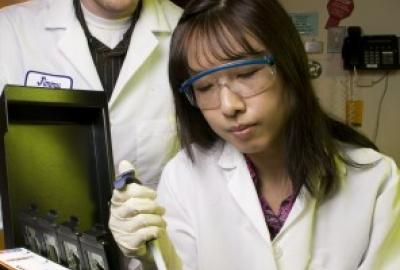
The Livermore team, in collaboration with Statens Serum Institut in Denmark, have demonstrated the potential and real life utility of the microarray technique for broad-spectrum pathogen detection in clinical samples. Their results are published in the online journal PLoS ONE.


